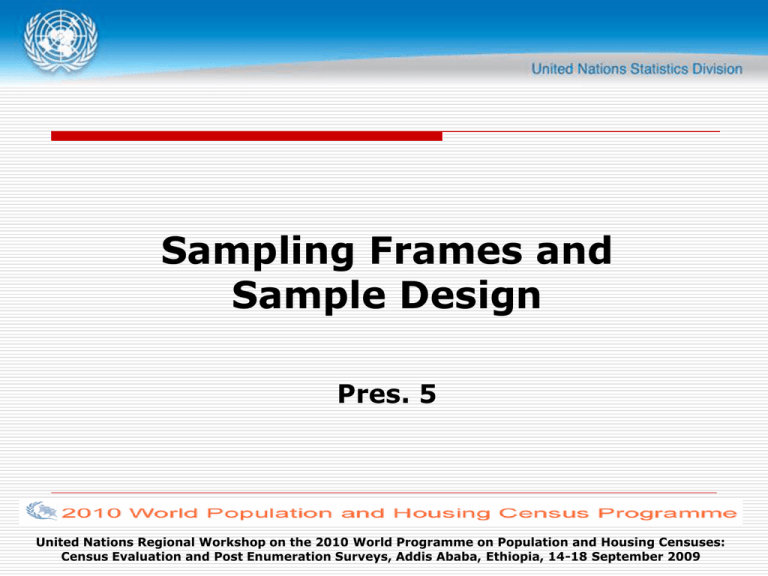Sampling Frames and Sample Design Pres. 5
advertisement

Sampling Frames and Sample Design Pres. 5 United Nations Regional Workshop on the 2010 World Programme on Population and Housing Censuses: Census Evaluation and Post Enumeration Surveys, Addis Ababa, Ethiopia, 14-18 September 2009 Sample Frames & Sample Design Frames: Material from which a sample is drawn Each unit to be included in the universe There should be no duplicates Each unit should be well defined and distinguishable from other units (it should be unique) Should be updated For PES first stage units Primary Sampling Units (PSUs), in many countries area clusters United Nations Regional Workshop on the 2010 World Programme on Population and Housing Censuses: Census Evaluation and Post Enumeration Surveys, Addis Ababa, Ethiopia, 14-18 September 2009 Choices of PSUs Must have clearly identifiable and stable boundaries Must completely cover the relevant population Preferably must have measures of size They should be mapped Must cover the whole country The number of PSUs must be relatively large United Nations Regional Workshop on the 2010 World Programme on Population and Housing Censuses: Census Evaluation and Post Enumeration Surveys, Addis Ababa, Ethiopia, 14-18 September 2009 Common problems with EAs Incomplete coverage Inadequate maps Poor measures of size or lack of them United Nations Regional Workshop on the 2010 World Programme on Population and Housing Censuses: Census Evaluation and Post Enumeration Surveys, Addis Ababa, Ethiopia, 14-18 September 2009 Sampling Strategies Probability household surveys It is usual to make inferences in a PES for a number of analytical domains Relatively large samples necessary in each domain for reliable estimates Stratified cluster sample design-common First-stage units–area clusters/EAs PPS systematic sample selection Second-stage, common to canvass all persons in selected households United Nations Regional Workshop on the 2010 World Programme on Population and Housing Censuses: Census Evaluation and Post Enumeration Surveys, Addis Ababa, Ethiopia, 14-18 September 2009 Multi-stage Cluster Sampling Usually used when sampling hierarchical populations e.g. persons within households which can be selected from EAs The hierarchical levels are called stages First stage units are called primary sampling units (PSUs) e.g. EAs Second stage units are called secondary sampling units (SSUs) e.g. households Last stage units are called ultimate sampling units (USUs) e.g. persons United Nations Regional Workshop on the 2010 World Programme on Population and Housing Censuses: Census Evaluation and Post Enumeration Surveys, Addis Ababa, Ethiopia, 14-18 September 2009 Why Area sampling? At national level only a frame of EAs is required Data collection is more efficient Lower costs compared to simple random sampling (SRS) Supervision is easier However, estimates are prone to higher variability compared to SRS United Nations Regional Workshop on the 2010 World Programme on Population and Housing Censuses: Census Evaluation and Post Enumeration Surveys, Addis Ababa, Ethiopia, 14-18 September 2009 Importance of Stratification Population subdivided into heterogeneous groups that are internally homogenous Stratification based on variables correlated with the extent of coverage-geopolitical subdivisions Internal homogeneity can be maintained with regard to socio-demographic variables e.g. urban stratum Common strata may include: rural, urban, provinces etc. United Nations Regional Workshop on the 2010 World Programme on Population and Housing Censuses: Census Evaluation and Post Enumeration Surveys, Addis Ababa, Ethiopia, 14-18 September 2009 PES sample design A single-stage stratified clustered sample design is commonly adopted When the PSUs i.e. EAs are selected all households in selected EAs are canvassed This is necessary because they have to be matched with the census population United Nations Regional Workshop on the 2010 World Programme on Population and Housing Censuses: Census Evaluation and Post Enumeration Surveys, Addis Ababa, Ethiopia, 14-18 September 2009 PES sample selection First stage units selected are PSUs (EAs) At the next stage all households in selected EAs are included in the sample United Nations Regional Workshop on the 2010 World Programme on Population and Housing Censuses: Census Evaluation and Post Enumeration Surveys, Addis Ababa, Ethiopia, 14-18 September 2009 Sample Size Sample size depends on estimate requirements Geographic level (national, province, urban/rural) Demographic (sex, age) Reliability Confidence level United Nations Regional Workshop on the 2010 World Programme on Population and Housing Censuses: Census Evaluation and Post Enumeration Surveys, Addis Ababa, Ethiopia, 14-18 September 2009 Sample Size To estimate sample size in the case of proportions you must: Know the occurrence of the event in the population Specify a confidence interval Specify the margin of error or precision To estimate percentage of households with access to family planning services about 55%; confidence interval for a standard error of 2 % pq 55 x 45 n 619 The sample size works out to be: h ( sd ) 2 4 United Nations Regional Workshop on the 2010 World Programme on Population and Housing Censuses: Census Evaluation and Post Enumeration Surveys, Addis Ababa, Ethiopia, 14-18 September 2009 Sample Size Adjusting for non-response, e.g. 10%: 619 688 0.90 Adjusting for the design effect for a complex sample design Design effect of 2 is a default value : 2 x 688 =1,376 This may apply to each province (analysis) domains. If they are five provinces Sample size will be 5 x 1, 376 = 6,880 United Nations Regional Workshop on the 2010 World Programme on Population and Housing Censuses: Census Evaluation and Post Enumeration Surveys, Addis Ababa, Ethiopia, 14-18 September 2009 Sample Size United Nations Regional Workshop on the 2010 World Programme on Population and Housing Censuses: Census Evaluation and Post Enumeration Surveys, Addis Ababa, Ethiopia, 14-18 September 2009 Sample Size United Nations Regional Workshop on the 2010 World Programme on Population and Housing Censuses: Census Evaluation and Post Enumeration Surveys, Addis Ababa, Ethiopia, 14-18 September 2009 Sample Size United Nations Regional Workshop on the 2010 World Programme on Population and Housing Censuses: Census Evaluation and Post Enumeration Surveys, Addis Ababa, Ethiopia, 14-18 September 2009 Thank You! United Nations Regional Workshop on the 2010 World Programme on Population and Housing Censuses: Census Evaluation and Post Enumeration Surveys, Addis Ababa, Ethiopia, 14-18 September 2009




